LG 32UD99 Ultra HD HDR FreeSync Monitor Review
Why you can trust Tom's Hardware
Grayscale, Gamma & Color
We narrowed the 16 picture modes down to three for our tests: Custom, Rec.709, and HDR Effect. The fourth set of charts indicates the calibration we performed in Custom. The other two presets are fixed and cannot be adjusted.
Grayscale Tracking
Our grayscale and gamma tests are described in detail here.
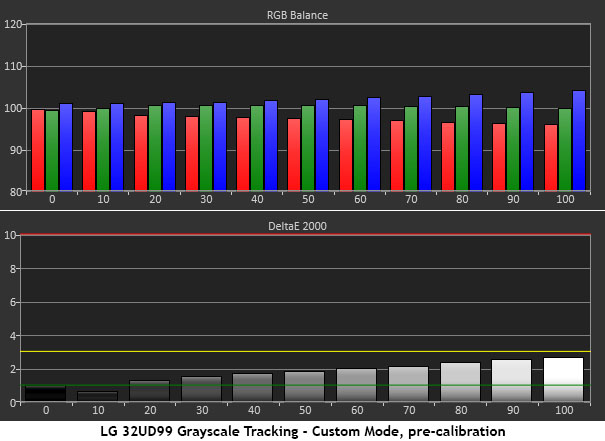

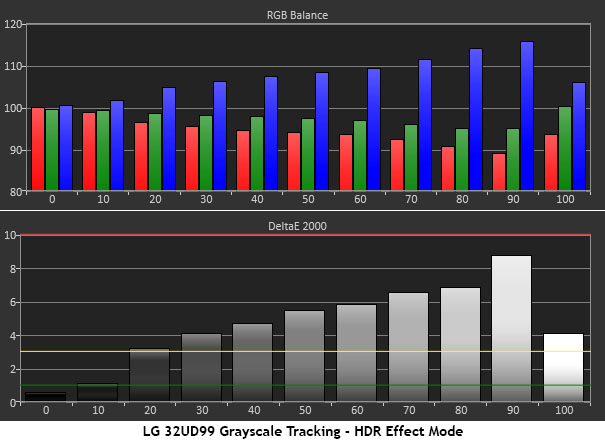
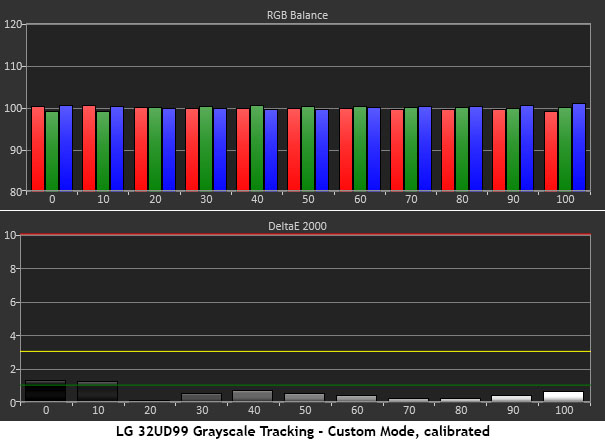
Most users, professionals included, will be just fine with the 32UD99’s Custom mode and its default settings. Our chart runs slightly blue, but all errors are below the visible threshold of 3dE. This is excellent performance, especially for the money. Rec.709 is slightly off the mark in the brighter steps, but still fine for pro-graphics tasks. HDR Effect is a personal taste mode and doesn’t conform to any established standards. Its grayscale is decidedly blue, which enhances the perception of brightness at the expense of color accuracy. As you’ll see below, it makes some changes to gamma tracking as well.
Calibrating the RGB sliders results in even better grayscale tracking with all errors under 1dE save the 0 and the 10% levels. It can’t get much better than that.
Comparisons
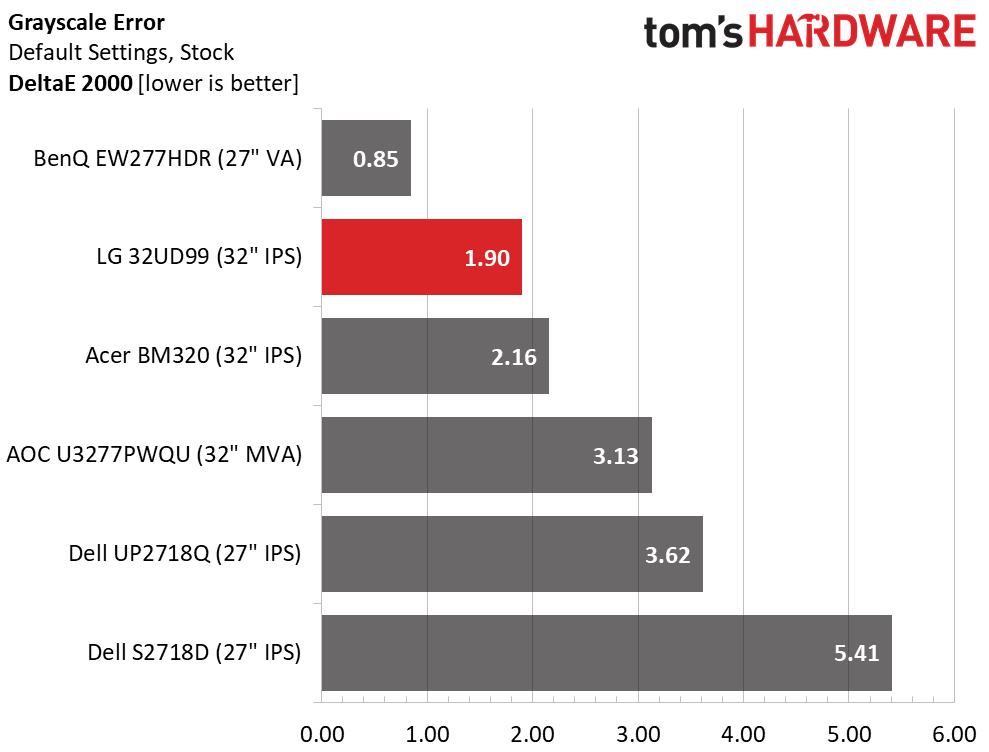

1.9dE is perfectly acceptable out-of-box performance for any professional monitor, and well within the data sheet provided with our sample LG 32UD99. Calibration is certainly unnecessary in Custom or Rec.709 modes, but if one can achieve .52dE, then why not? Our tweaks took all of 10 minutes and rewarded us with some of the best tracking we’ve ever recorded. This is excellent performance, especially at LG’s chosen price point.
Gamma Response
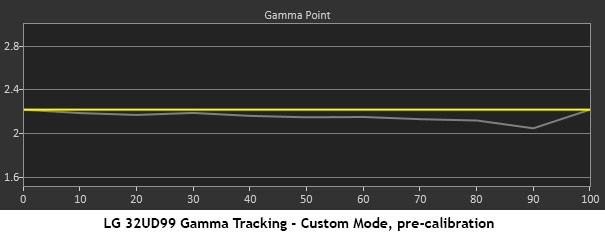
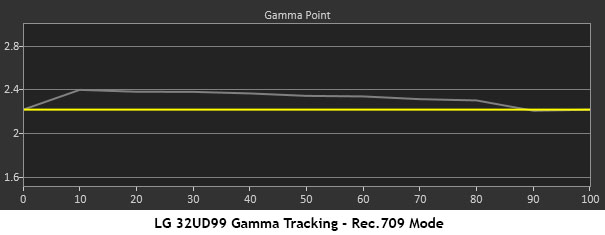
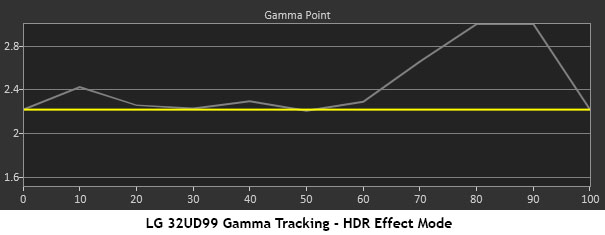

Gamma is a key factor for both SDR and HDR material. We’ll test the 32UD99’s actual EOTF on the next page, but we’re showing what happens in HDR Effect mode right here. There is dynamic contrast in operation, and we could see each test pattern shift as it was displayed. By slowing our measurement sequence, we got a good snapshot of the monitor’s luminance manipulation. Tracking stays relatively straight until 60%, where the light level rises more slowly. The visible effect makes the overall image look darker, except for the brightest highlights which pop out as they should. Some users may like this approach, others (us included) may not. Nothing will beat true HDR-encoded content of course, but this method is not without merit.
In both Custom and Rec.709 modes, gamma tracks the 2.2 power function closely on the Mode 2 preset. Adjusting the RGB sliders won’t impact luminance if you leave the Contrast slider at its default setting.
Get Tom's Hardware's best news and in-depth reviews, straight to your inbox.
Comparisons
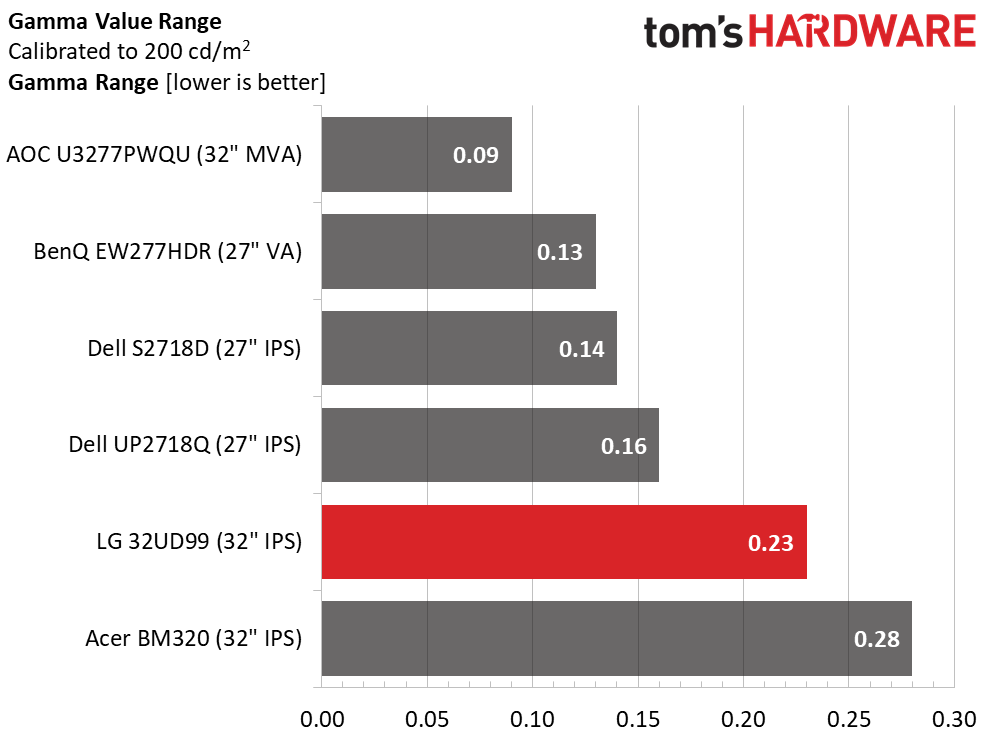

All the monitors here sport excellent gamma tracking, so differences are minor. The LG 32UD99 has a slightly greater range of values and misses the 2.2 spec by 5.45%, with a 2.08 average value. That’s mainly due to the shift between 60 and 90%, but we’re talking about a very slight error. We have no visual issues to report here.
Color Gamut & Luminance
The LG 32UD99 is a two-gamut monitor. Custom delivers DCI-P3, while sRGB and Rec.709 hit those standards with precision. If you want to tweak further in the CMS, you’ll have to work with DCI. The other two gamuts are not adjustable.
For details on our color gamut testing and volume calculations, please click here.
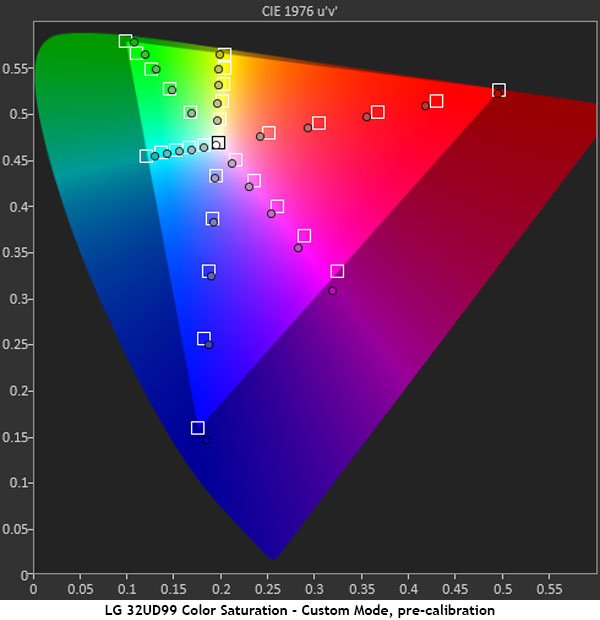

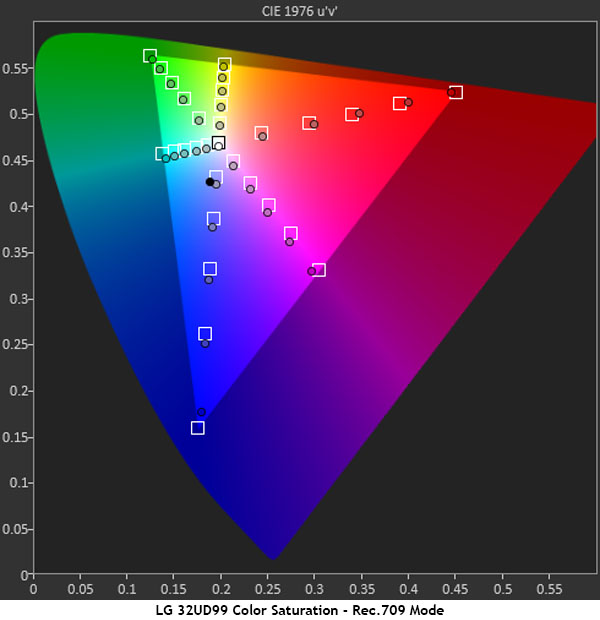

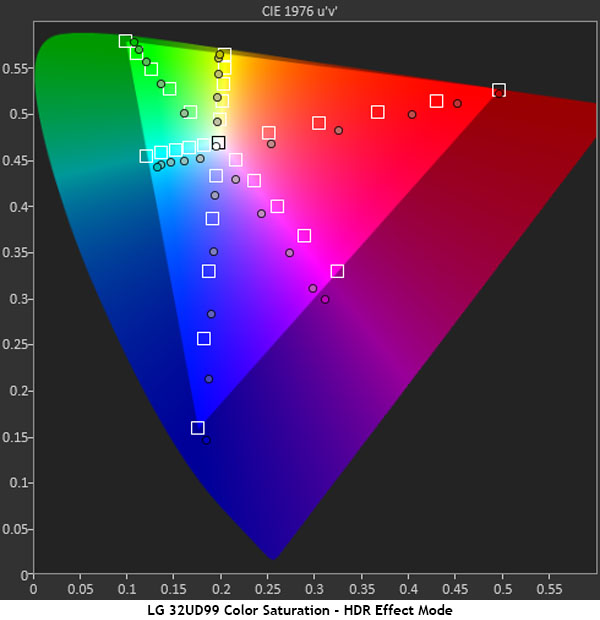
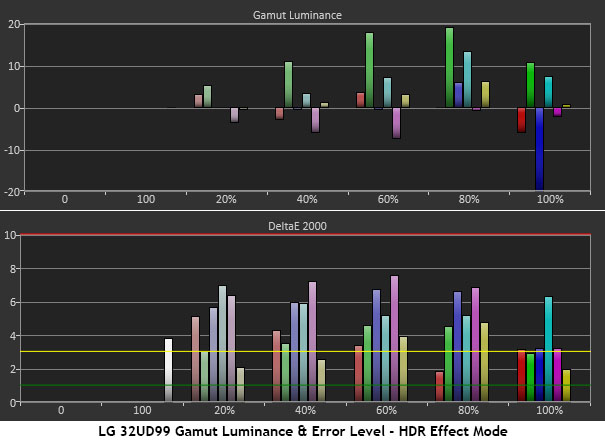

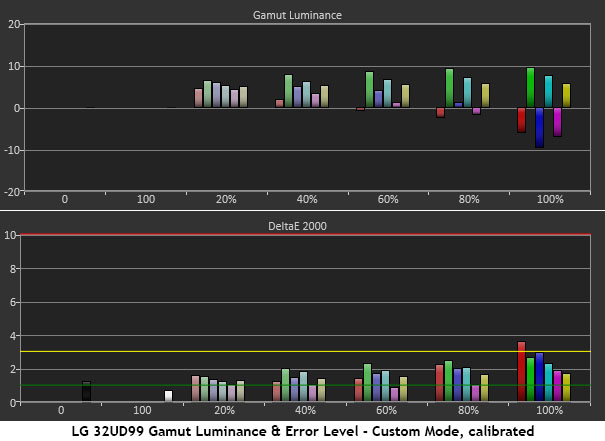
Thanks to excellent grayscale and gamma tracking, the LG 32UD99’s color saturation points are all in contact with their target squares. Only the magenta secondary is slightly out of phase before calibration. This is an invisible error, but it’s easily corrected with tweaks to the RGB sliders. The gamma preset is fine as is. The fixed Rec.709 mode has no visible errors in either the gamut or luminance charts. HDR Effect pulls red, magenta, and cyan off their hue targets, but keeps saturation levels reasonably close to the correct DCI-P3 points. Calibration results in an almost-perfect gamut and luminance result, with only 100% red showing a barely visible error.
Comparisons


1.77dE represents our calibration in the Custom mode. The default measurement is 2.16dE, which is visually indistinguishable from the adjusted figure. Rec.709 delivers 1.82dE, which is about as good as it gets for out-of-box performance. The most expensive monitor, Dell’s UP2718Q, is good at the default settings, but requires a software calibration to reach full potential.
Our 90.69% sRGB volume result surprised us a little. If you look closely at the charts, red and blue are slightly under-saturated. It’s enough to shave off that 9.31%. DCI-P3 volume doesn’t appear on the chart, but we measured it at 89.68%, a little under LG’s 95% claim. All monitors will benefit from a custom IEC profile. We recommend them for professional use in every case.
MORE: Best Gaming Monitors
MORE: How To Choose A Monitor
MORE: All Monitor Content

Christian Eberle is a Contributing Editor for Tom's Hardware US. He's a veteran reviewer of A/V equipment, specializing in monitors. Christian began his obsession with tech when he built his first PC in 1991, a 286 running DOS 3.0 at a blazing 12MHz. In 2006, he undertook training from the Imaging Science Foundation in video calibration and testing and thus started a passion for precise imaging that persists to this day. He is also a professional musician with a degree from the New England Conservatory as a classical bassoonist which he used to good effect as a performer with the West Point Army Band from 1987 to 2013. He enjoys watching movies and listening to high-end audio in his custom-built home theater and can be seen riding trails near his home on a race-ready ICE VTX recumbent trike. Christian enjoys the endless summer in Florida where he lives with his wife and Chihuahua and plays with orchestras around the state.
-
Tanquen Just some random thoughts. Not sure I’m keeping it. (Returned it as the image would black out randomly and the other issues below)Reply
The included cables are way too short. Better than nothing but you best be using them with a laptop right next to the display. They should have done better on a $1k display. It seems they had to make the USB-C cable beefy and short as my other USB-C cable that I just upgraded to because my new Pixel 2 don’t like the poorer(?) quality older ones I had that worked fine with the Pixel 1 don’t work with the LG. The calibration has issues with the included USB and even the Windows app had issues.
The USB connection, while troublesome did finally work and the screen adjustment app is cool and I was able to update the displays firmware. Never done that with a display before.
It’s flat screen! Yeah! Not sure why everyone seems to be into pinching the middle of the screen and flaring the corners when we finally got rid of this type of distortion moving from CRTs?
It’s 16:9. Boo. The only option for 16:10 are other 30” displays like the newer U3017 but none I can find with a res higher than 2560x1600.
The Vesa Mount. It has one but it’s off center and mounts too high on my Ergotron arm. Boo! I know they want to put the hardware and stuff low on TVs and such too make the top look so thin but I’d rather have the vesa mount centered. Looking at getting a new TV and will have to redo the wall mount. :(
May try one of these on this display:
https://www.ergodirect.com/product_...x9_SZgwtY21GVa1c8oSqP8r4Gzk06RQUaAgHTEALw_wcB
https://www.newegg.com/Product/Prod...cCdSXCAMdHOdAebexS8aAlaNEALw_wcB&gclsrc=aw.ds
Size. Not a full 32” but that is how they do it. The small bezel is nice. No logo is nice too but, the display adjustments are on the bottom and this limits your multi mount options.
Built in speakers. Not the best sound but handy if you move the monitor around or in years to come when you just want simple sound without setting up extra speakers.
Anti-glare coating. Maybe it gets them a brighter screen but the LG shows way more than the Dell. Not mirror like but I see lots of light sources like me and my desk in the LG.
The display was shipped in a metallic bag with a lining but no extra screen protection. There are some permanent spots seen when cleaning and it’s much harder to clean. Like the coating is more porous. It took me some time to clean my finger prints off. Never wanted a pair of kit gloves before.
Calibration. The whites are more so then the Dell but a bit blue for me. The built in calibration sounded good but it’s next to imposable to get running and when you do, it adds banding.
Power. See this more and more but it has an external AC adapter. So my existing power cables won’t work. I did find an IEC Socket C14 to Cloverleaf Plug C5 Adapter but still had to mount the power brick.
It has some response time adjustments but I can’t see the difference between any of them and the motion blur is noticeably worse than the seven year old Dell.
Freesync. Glad it has it but can’t seem to get it to work.
HDR. Again, glad it’s there but none of the games I have support it and I can’t see anyway to play an HDR video to try it out. :(
The extra res is good and bad. The Dell U3011 30” at 2560x1600 is a good spot to be as I can run at 100% PDI and still read everything. With the new 4k display I’d need it to be 40” or something. With this 32”-ish display I have to up the DPI and still in 2018 Windows 10 has some issues scaling windows. Some apps or windows ignore the DPI setting or look like scaled bitmaps.
The IPS Glow is a bit worse than the 6-7 year old Dell but this may have something to do with the coating and the much greater focus on brightness and HDR. It takes some getting used to. The whites are also a bit blue.
And twice today there was a slight popping sound and an onscreen glitch to go with it. Got it from B&H for $880 or so and it's a good price at the moment. So, I can return and wait for them to get them in stock again or just return it. Thinking I should just return it.
Can't even try out Netflix 4k HDR as AMD has no Display Ready 3 or whatever. :(
Overall, I'm disappointed. The one game I could try with HDR (Hitman) seems like nothing changes with it on but you can’t just toggle it back and forth.
Freesync also doesn’t seem to work and it has more motion blur eventhough its listed as being faster than my old displays.
-
davidgirgis "Between the product photos and the different logos that appear, one can make out just what the LG expect the display is be doing."Reply
Is this English? -
AnimeMania Which video ports can be used for Freesync? Does HDR require certain video ports or can any be used?Reply -
Ilya__ Reply20749782 said:"Between the product photos and the different logos that appear, one can make out just what the LG expect the display is be doing."
Is this English?
People think the products not be like it is, but it do. -
hannibal It seems to be Vesa HDR400 monitorReply
https://displayhdr.org/performance-criteria/
Because max brightness is less than 600 nits. But it is close to it. So it is almost Vesa HDR600 compatible -
truerock I hate it when they put speakers, USB ports and other unrelated crap inside a video monitor. I wish they wouldn't do that. I like the trend that Samsung is starting with its TVs where all the ports and other non-video-monitor stuff is put in a separate box.Reply -
lukwtwz How did you measure total input lag? I ask because the 65ms you reported is several times higher than the highest figure reported in any professional review of this monitor I've read so far.Reply